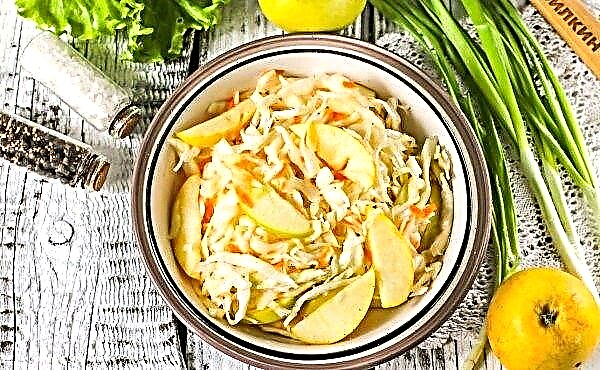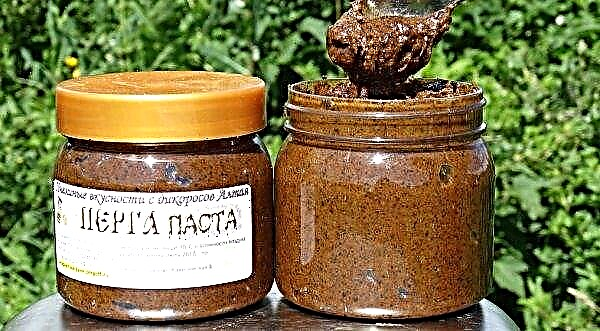One of the most beautiful conifers is the prickly spruce Blue Mountain. (Picea pungens blue mountain) Her crown is painted in saturated color and has the shape of a cone, being a real decoration for any site. The tree is unpretentious in care and grows well even in the conditions of the city, as it normally tolerates polluted air. A detailed description of the Blue Mountain spruce, its use in landscape design, as well as the features of planting and care, is further in the article.
Grade description
Translated from English, Blue Mountain means "blue mountain." This variety of fir got its name due to its large size and the bluish color of the needles. Under natural conditions, the tree grows in North America and can reach 30 m in height.
Did you know? The main root of spruce dies in 10-15 years after planting. Instead, many branched roots are formed, located close to the surface of the soil.
Description of Spruce Blue Mountain spiny:
- The tree is fast-growing, has a straight and strong trunk. The annual growth is about 35 cm.
- When grown in areas, the height of the adult spruce usually does not exceed 20 m. The diameter of the lower part of the crown is up to 8 m.
- The shoots are evenly covered with blue needles and form dense horizontal tiers around the trunk.
- The spruce crown has a conical shape and consists of branches extending from the trunk at a right angle. Some shoots may be located at a slight slope up.
- Needles are needle-shaped, dense and long. Outside, there is a thin layer of wax on it, which gives the crown of the spruce a silver tint.
- The cones are cylindrical and large in size, reaching a length of 8 cm. At first they are painted in a greenish-brown color, and as they mature, they become light brown.
In landscape design
Due to the decorative appearance of the crown, Blue Mountain spruce is often used to decorate areas, combining perfectly with the green lawn. The tree is also grown in urban parks and near multi-story buildings, purifying the air around it from harmful impurities.
In landscape design, this variety can be used as follows:
- to create coniferous alleys;
- in single landings;
- to form the framing of the site;
- in compositions with other coniferous crops;
- for landscaping near buildings made of brick or stone;
- in groups with deciduous trees;
- to create compositions near water bodies.
Terms & Conditions
Spruce Blue Mountain retains the decorative color of needles throughout the calendar year, and it can be grown in regions with a temperate climate.

The tree is unpretentious to environmental conditions, but so that the crown is always bright and fluffy, when choosing a place for planting, they adhere to such recommendations:
- the site should be well lit by the sun - this contributes to the active growth of spruce and gives a rich color to the needles;
- young seedlings need to be planted at a certain distance from other trees and structures, since an adult specimen requires a lot of space;
- the soil should be fertile and loose, good moisture permeability - the ideal option is sandy loam or loamy soil;
- It is best to place seedlings on the north side of the buildings so that in the spring shoots and needles do not get burns from the bright sun.
Important! It is not recommended to plant the Blue Mountain variety close to the windows of the buildings. Thick needles will poorly transmit sunlight, creating a shadow in the room.
Step-by-step landing
The procedure for planting seedlings of spruce Blue Mountain is not difficult. If the seedling was purchased in a container, then you can close its roots in open ground at any time of the year. Most often, landing is performed in the spring.

In order for the young seedling to take root more quickly in the chosen place, it is recommended to add a little sand or earth taken at the foot of the conifer in the forest to the planting pit. You can also use store soil for conifers.
Step-by-step landing instructions:
- Dig a landing pit about 60 cm deep. Its width should be such as to fully accommodate the roots of a seedling and an earthen lump around them.
- At the bottom of the recess lay a layer of drainage from broken brick or pebbles.
- Put the roots of the young spruce in the recess with an earthen lump. Sprinkle the pit with loose soil in half.
- Pour a small amount of warm water with a sapling to moisten the soil well. After absorbing the fluid, lightly tamp the surface of the soil around the trunk.
- Fill the landing pit to the very top with the remaining soil, tamp. Water the tree again with warm water.

Care Features
If the spruce was planted according to the rules listed above, the seedling will quickly take root and begin to grow actively. Representatives of the Blue Mountain variety are unpretentious in care, tolerate drought and low temperatures well, so gardeners usually do not have difficulties with growing these trees.
Important! Blue Mountain spruce can withstand frosts down to -34 ° C, so you do not need to additionally cover the tree for the winter.
Basic care rules:
- young specimens are watered only in the warm season with a small amount of water - the root system of conifers does not respond well to waterlogging and stagnation of water in the soil;
- after planting, the soil surface around the seedlings is mulched with peat or dry sawdust - this will help prevent weeds from growing and will allow moisture to be retained in the soil longer;
- adult specimens should be watered only during severe summer droughts, moistening the earth with a moderate amount of water;
- in March, top dressing is introduced in the form of a complex store fertilizer for coniferous crops - in this case, you must carefully follow the instructions on the package;
- so that the branches of young seedlings do not break under the weight of the snow cover, for the winter they are slightly pressed to the trunk with a rope;
- in the spring, the spruce is covered with agrofibre or a thin cotton cloth - this helps protect the crown and trunk surface from sunburn;
- tree formation begins after it reaches a height of 1.5 m - for this, dry branches are cut in early spring, young shoots are shortened, giving the spruce a regular conical shape.

Growing the Blue Mountain variety on the site is easy, and an adult tree will become a real decoration for any locality. Using the information presented in the article, you can choose the most suitable place for a representative of this variety and land correctly, creating bright decorative compositions.












